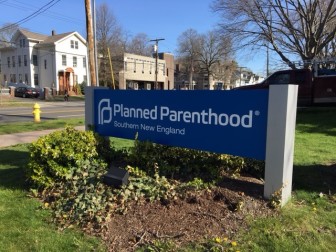Several times every month, protesters come to the New Haven Planned Parenthood of Southern New England office to hold signs and pray the rosary.
![]() Planned Parenthood serves about 64,000 Connecticut patients a year, though according to a recent annual report, abortions are only about six percent of its services. Most of the services revolve around providing contraceptive services and testing for sexually transmitted diseases.
Planned Parenthood serves about 64,000 Connecticut patients a year, though according to a recent annual report, abortions are only about six percent of its services. Most of the services revolve around providing contraceptive services and testing for sexually transmitted diseases.
Last month, the federal Food and Drug Administration eased restrictions on the so-called abortion pill, also known as RU-486. The new rules allow women to use the drug later in their pregnancies with less visits to the doctor. The change reflects the protocol suggested by many medical professionals already, as well as improved testing regimens, said Susan Yolen, vice president for policy and advocacy at Planned Parenthood of Southern New England.
When the change was announced, NARAL Pro-Choice America said that the pill is safer than Tylenol, or even Viagra. Nevertheless, a day after the announcement, Gov. Doug Ducey of Arizona signed a law that requires clinics to follow the original FDA protocol. That’s because Ducey, who earned his medical degree at—oh, wait. He didn’t. Ducey came to office after a career spent in business, but with this throwback-of-a-law, he joined the ranks of politicians-who-would-be-doctors.

Planned Parenthood serves about 64,000 CT patients a year.
Here in Connecticut, we mostly prefer the people who practice medicine to have earned some sort of medical degree. Consequently, Connecticut has some of the country’s most progressive abortion policies, according to the Guttmacher Institute. This is, after all, the state that gave birth to Griswold v. Connecticut. Here, for now, a woman’s reproductive decision rests between a woman and her medical care provider.
“I think our whole message to the world right now would be: Who should be practicing medicine, really?” said Yolen. “People who know what they’re doing, physicians and providers, or politicians?”
The drug’s original, stricter protocol, said Yolen, was based on trials in the 1990s.
“Now we fast-forward 20-some years, and hundreds of thousands of women have actually used the product successfully,” she said. “The new learning from that much larger base of people what’s effective and what’s best practice is driving the change.”
The drug, mifepristone, was approved by the FDA in 2000, but guidelines required that the drug be administered by a doctor, in a doctor’s office. The procedure is actually two drugs: mifepristone, as well as misoprostol, which is taken a few days after a doctor’s visit for the first drug. The first drug blocks progesterone, the hormone necessary to maintain a pregnancy, and the second causes the uterus to expel the pregnancy. A third visit to the doctor allowed a doctor to make sure the fertilized egg had been expelled.
Part of the recent change from the FDA said that qualified health care providers—not just doctors—can administer the drugs.
That’s pretty much what has been happening anyway, and members of the American Congress of Obstetricians and Gynecologists are in favor. The organization’s president said the new rules will “give women more time to make the decision that is right for them.” The new guidelines will, as well, make abortion more accessible to more women, particularly those living in rural areas, and those who are traditionally underserved.

FDA recently eased restrictions on RU-486.
Roughly half of women who choose abortions choose abortion by medication, says Planned Parenthood. Research shows that abortions can be achieved with a lower dose— 200 milligrams as opposed to 600, as was previously administered.
Ironically, the decision is coming on the heels a countrywide record pace of abortion clinic closures. Five states have just one clinic apiece.
Not so in Connecticut. Protesters continue to show up outside New Haven’s Planned Parenthood on days they believe surgical abortions are offered, but medical abortions, what Yolen calls an “increasingly welcome choice” for women, are offered any day.